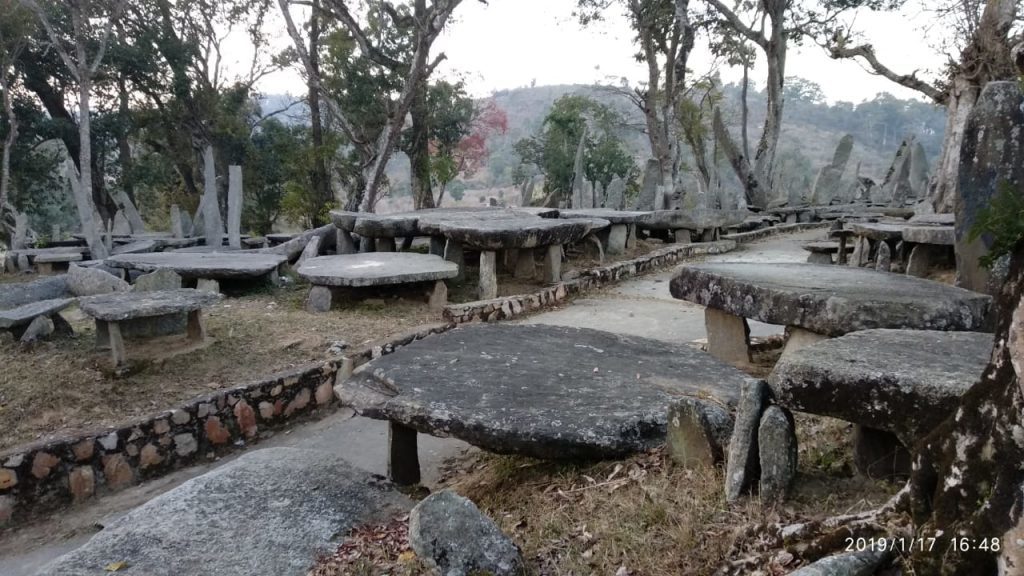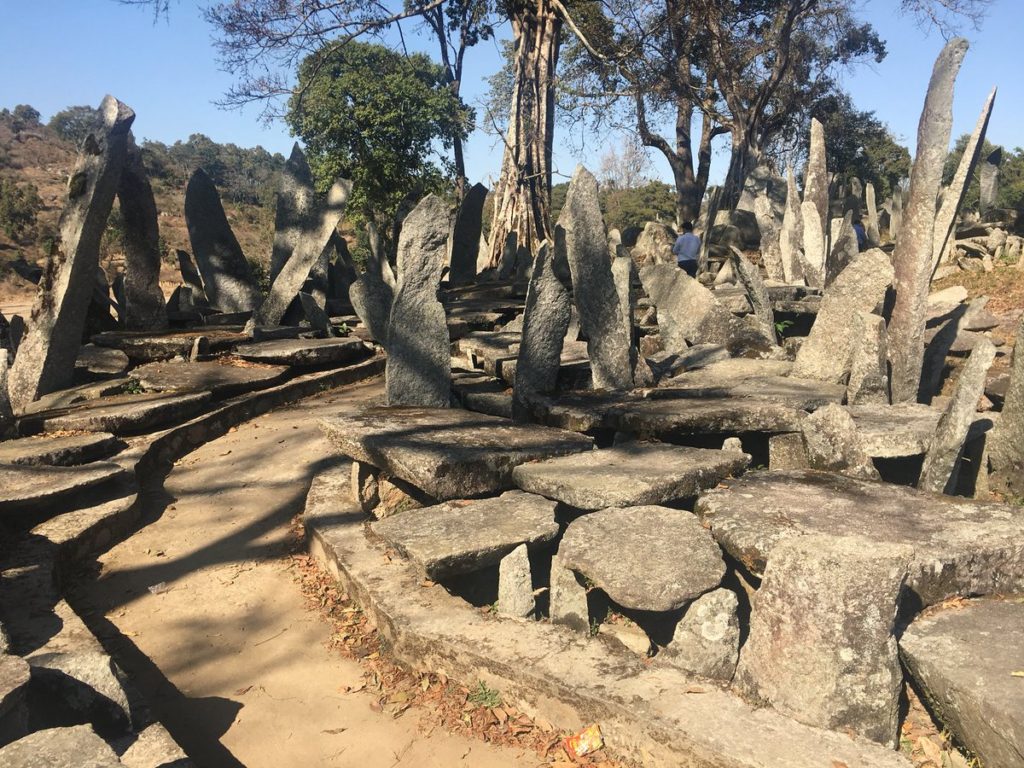
The Jaintia Hills are home to Nartiang village, 63 kilometers east of Shillong, where you can visit an intriguing complex of stone monoliths erected by different clans between the 16th and 19th centuries – the largest concentration of many monolith groups in Meghalaya. Also at Nartiang is an ancient Durga temple, formerly used for human sacrifices.

Monoliths exist throughout the length and breadth of the Khasi and Jaintia Hills. However, the biggest collection of monoliths or Megalithic stones in one single area is to be found north of the Nartiang market. These consist of Menhirs (Upright stones) Moo Shynrang and Dolmens (flat stones in the horizontal position) locally known as Moo Kynthai. Within the perimeter of these Megalithic collections stands the tallest Menhir erected by U Mar Phalyngki a trusted lieutenant of the Jaintia King to commemorate his victory in battle. Other monoliths were erected by U Mar Phalyngki, U Luh Lyngskor Lamare and various clans of Nartiang village between 1500 A.D.and l835 A.D.

Origin of the monoliths: There is a story about how the monoliths came into being, which the Nartiang residences usually recites to the tourists visiting the Heritage site. The kings and the general officials of the Jaintiapur kingdom regularly visited Nartiang for their work and also Nartiang was considered to be one of the most developed human settlements at that time.

The origin of the largest monolith is varied. According to locals, on one rainy afternoon Jaintia king U Luh Lyngshkor went to an old woman’s hut at Raliang, a village near Nartiang seeking for a ‘Knub’ (a bamboo cape used by the locals to protect themselves from rain, hung from the head and runs down the back). The woman declined Luh’s request by insisting that he, being a strong man, should use the giant stone slab at the market in Raliang to shelter himself. On hearing this, Luh went to the market and used the giant stone slab to shelter from the rain. The slab was put down by him in Nartiang- also marking the shift of the market from Raliang to Nartiang.

The stones were said to be carried all the way from Jaintiapur. These stones were used by the people as umbrellas to shelter themselves from rain. There are two types of stones present there; “Moo Shyndrang” were usually called the male stones and are vertically placed (also called standing stones), and the “Moo Kynthai” were considered to be the female stones placed horizontally (also called sleeping stones)

The tallest monolith in the world is Moo Shyndrang placed exactly in the middle of the site, which is 08 metres tall and is believed to have been carried by U Mar Phalyngki (a trusted Lieutenant of the Jaintia Kingdom.) Also, there were other people who are known to have a contribution in the same, like U Luh Lamare and other various clan members. The beauty of the place is so immeasurable. There is so much to learn about that place. The beauty of history is highlighted in those stones. The lives of the people and their strength and their culture are also being made known to us from this site.

Attraction: Nartiang Durga Temple is a 600-year-old Durga Temple located in the West Jaintia Hills district of Meghalaya, a state in North-Eastern India. This temple is one of the 51 Shakti Peethas and is one of the holiest sites for devotees of the Shaktism sect of Hinduism. The tribal Hindus in the Jaintia Hills of Meghalaya believe that this temple is the permanent abode of Goddess Durga. The temple draws a large number of pilgrims from all over the country on the occasion of Durga Puja. The Shakti of Nartiang Devi shrine is worshipped as Jayanti and the Bhairava as Kamadishwar.

I believe that every Meghalayan should be proudly announcing to the world about this beautiful historical site. It is one of its best kind in the world. But it is also very heartbreaking to state that a very few numbers of people know about these Monoliths. Instead, the praises about these beautiful stones should be readily available in every residing mouth of the land. Though the site is under the care of the Archaeological Survey of India, there is very little documented information on the monoliths of Nartiang.

It is high time that students of history and archeology join hands to undertake a detailed study on the monoliths. Just categorising the monoliths as the world’s tallest is not the end of the story. The world needs to know in detail the story of how or why the Jaintia kings gave us these beautiful monoliths. Traditionally, tribal history has been primarily oral, and there is little documentation done during the British era.

Communication: Airways: The nearest airport is Lokpriya Gopinath Bordoloi International Airport (GAU) in Guwahati is the nearest airport and then have to drive 105 kilometers. Jowai is Shillong Airport, (SHL) which is located in Umroi near Umiam lake is close but the frequency is less. Railways: The nearest railway station is Guwahati Railway Station (GHY). It is 105 kilometers from Shillong and very well connected with all major cities of India. Meghalaya Transport Corporation (MTC) has bus services coordinated with train arrivals at Guwahati. Roadways: Nearly 105 kilometers with the all-weather road is nearly 03 hours drive. It is located to the north of Nartiang market. Taxis can be booked to visit the monoliths.

Let’s spend the time together! Contact: www.dreamwaydestinations.com & www.visittobengal.com Or Call me at +919733465000 & +919474092500 Or WhatsApp : +918617432205